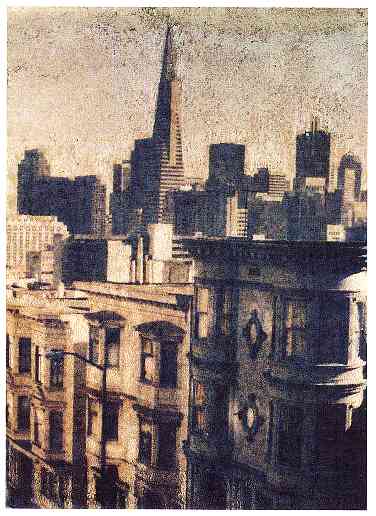
 SAN FRANCISCO - Shortly after its release last fall, the Atari ST version of SimCity, an addictive computer simulation of a modern metropolis, infected the editorial staff of START Magazine. Editors argued about who would take the office copy of the game home for the weekend, shared tax tips and played for hours. "my Sims love me." said START Editor Tom Byron, proud mayor of Byronsburg. "I have a 97 percent approval rating." Technical Editor James Burton, mayor of Testville, caught such a severe case of SimCityitis that he wrote a cheat, a "city federal loan application" program which solves a SimCity mayor's biggest obstacle to growth, lack of funds. Associate Editor Amy H. Johnson attributes part of her success at governing Amicus to management strategies she learned from The SimCity Planning Commission Handbook. "It explained some of the theory behind the simulation," she said, "and gave me some ideas about how to balance the variables." Byron announced plans to spread SimCityitis through more of the Atari community by publishing a special SimCity feature in the March 1991 issue of START. The feature will include a review of the game, Burton's cheat and an excerpt from The SimCity Planning Commission Handbook. "We admit it," Editor Byron said cheerfully. "We're addicted. Why shouldn't everyone be?" |
WELCOME TO
SIM
CITY
The Most Innovative Game In Years Causes Our Reviewer To Trade Her Role-Playing Sword For A Budgetary Ax
BY BETTY DEMUNN
Do you gripe and groan about your city's government? Well, here's an opportunity to put your money where your mouse is. Award-winning SimCity, the city-building simulation, is finally here for the ST and it's a stunner.
Your goal as mayor/city planner is to design, manage and maintain a thriving community. You start with a random terrain of earth, water and forests. Decide where to locate your residential, industrial and commercial zones. Install a power plant and roads, and watch those prolific little citizens (called Sims) move in. The yearly budget pops up and you must set tax rates, fund police, transportation and fire departments, and avoid deficit spending.
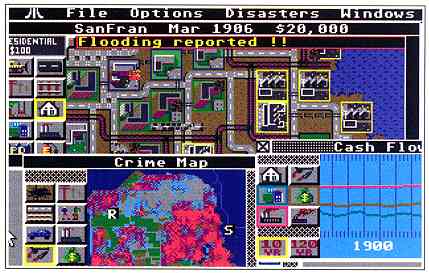
This is the simulated
neighborhood surrounding the
START offices in the
San Francisco scenario.
Urban Jungle
As your Dream City grows so do some ugly problems. Now you're plagued
with crime, pollution, traffic jams and slums. More roads! More rapid transit!
More police! More urban renewal! More parks! More everything, including
a stadium, airport and seaport. The Sims demand, and if you don't deliver
they move out and you're mayor of a ghost town.
Random disasters, such as floods, shipwrecks, fires, tornados and monster attacks, can cause expensive damage. Battling these unwelcome surprises is half the fun, but you can disable them if you're chicken.
A God's Eye View
Looking down, the townscape is moving, changing, evolving before your
eves. Everything "works": tiny traffic signals, planes, drawbridges, helicopters,
minute fountains in the park. Your city is alive thanks to peerless graphic
animation.
That's the basic play of SimCity, but there are other choices at startup. Included are eight scenarios of famous cities in various states of disaster - the 1906 San Francisco earthquake, Detroit's crime wave of '72, Tokyo's monster attack in '57, even a nuclear meltdown in Boston in 2010. You have limited time and money to correct or repair the problems. Win the key to the city or ride out of town on a rail.
Play SimCity easy, medium or hard. You're the policy maker. Call tip graphs to get a quick look at your progress. Tweak your budget, survey public opinion, check city maps. The game is crammed with countless options. To list them all would take a 51-page manual. Luckily one comes with the game, and deserves its own award for clarity and completeness.
Being GEM-based, SimCity has a familiar feel with icons and windows and menus galore. A mouse expedites gameplay, but the keyboard commands are quite painless.
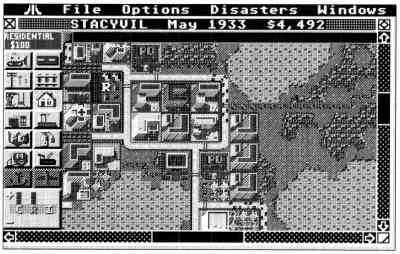
Life is good, but expensive
in Stacyville.
|
|
|
| Game:
Type: Company: Price: Requirements: Summary: Note: |
SimCity
Simulation Maxis Software 1042 Country Club Drive Suite C Moraga, CA 94556 (415) 376-6434 $49.95 512K, color monitor Unique and addictive; you gotta have it! SimCity comes on a double- sided disk. Contact Maxis for instructions on how to ex- change it for single-sided disks |
Uncharted Territory
As suggested in page 28 of the manual, I tried to print the map and
sketch my city plan before bulldozing. Unfortunately, the Atari Version
doesn't have a print option. The person I talked to at Maxis said that
suggestion should have been deleted from the Atari manual. Planning before
bulldozing is a good idea, though, so I did some experimenting.
There are two ways to print a SimCity map. First, call up the Map option, then press [Alt]-[Help] to print a screen dump. Be sure to set your control panel to 960 pixels/line first. To get any detailing, you must adjust the colors. Before printing, use the control panel to color the land blue, the forests red and the water green. It's ugly to look at on screen, but at least you can distinguish areas on the printout.
The other way is to use the Snapshot accessory to take a picture of the screen. Again, call up the Map option so all the territory is visible. Save your snapshot as a - PI1 file, then import it into DEGAS Elite. In DEGAS you can cut out the map portion and expand it to fill the whole screen, then print it.
The Old Gray Mayor
In its unique way, SimCity is addictive and infinitely replayable.
After a few sessions you'll have more compassion for those bumblers in
city hall. Personally, this old gray mayor ain't what she used to be.
Betty DeMunn is a stage actress who has played many roles, but not that of mayor.

THE CITY FEDERAL LOAN APPLICATION PROGRAM, OR,
A SIMCITY CHEAT
BY JAMES BURTON
TECHNICAL EDITOR
You're mayor of Poorville. You bulldozed your blighted downtown to make room for a massive redevelopment project that's going to cause land values to skyrocket, but you ran out of money before it could he finished. Or, you're mayor of Irwin Allenville, a city which has suffered an earthquake, a flood and several high-rise fires within the last month. Your budget is drained and you can't clean up the disasters. What's a mayor to do? Do what the big boys and girls do - ask the federal government for bailout money!
As a special service to our readers (and because the programmers at Maxis saw fit to provide only a measly "embezzlement" option, and only as an incentive to send in your registration card!) START presents the City Federal Loan Application Program on this months disk. The CFLAP provides another realistic detail to SimCity - deficit spending.
Using your backup START disk, follow the instructions in the file READ_ME to un-ARC LOANARC.PRG. The program LOAN.ACC will appear. Copy LOAN.ACC to your boot disk, or rename it LOAN.PRG and copy it onto your SimCity disk. Reboot, then play SimCity. When yon decide you need more cash, save your city, then select City Loan from the desk-accessory menu. If you renamed the program LOAN.PRG, then double-click on LOAN.PRG to run it. You'll see some instructions, then you'll be asked if you want to log on to the Federal Government Computer Network (using the Vapormodem which is built into every Atari ST).
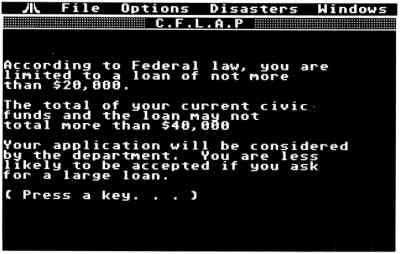
You'll have to wade through
some red tape before you get
your money. What else
is new?
Once you're online, you'll be asked for the name of your city, then for the amount of money you want. As dictated by federal law, you arc limited to a request of $20,000, and your request plus the funds you already have may not total more than $40,000. Smaller loans have a better chance of being granted. When you leave the loan program, load your city back into SimCity, then build that new airport!
By the way, there's a rumor that if you request a certain amount of money (somewhere in the millions), the governments Vapornet program will crash, leaving you with a ridiculously huge amount o)f money. . .

THE
SIMCITY
PLANNING COMMISSION
HANDBOOK
BY JOHNNY L. WILSON
When the START staff first saw The SimCity Planning Commission Handbook we pounced on it. Here, at last, were all the hints and tips that would keep us SimMayors from being booted out of office. Lacking any education or experience in city planning, we had, of course, failed miserably at our first attempts at governing. Crime spiraled out of control, pollution blanketed the city, housing costs soared, we spent wildly and quickly plunged into bankruptcy.
But then the Handbook arrived and gave us an inkling of how to manage the intricacies of city government. When we read the book again, our cities improved some more. Each time we read this book we learned something, because it explains the theory behind the game, and doesn't just list one-two-three hints (which would be difficult to do anyway).
The excerpt that follows is chapter 3 of The SimCity Planning Commission Handbook. It explains the model at the heart of the SimCity simulation: the relationship between the Sim population and the number and location of residential, commercial and industrial areas.
Chapter 3 The Population Bomb: Human Resources And Problems
A Chinese proverb reads: "Of all things, people are the most precious." Human resources are a double-edged sword, however. A concentrated population can be an asset, enhancing production and trade, or a liability. contributing to crime, pollution, and excess consumption. It is estimated that the current world population is increasing by over 200,000 people per day. This means that by the year 2000 an additional 2 billion people will have been added to the global population, equivalent to adding urban centers of approximately 5 million in population every 20 days for the rest of the decade. Such unprecedented growth is placing equally unprecedented demands on the worlds resources. Alvin Toffler, in The Third Wave, has compared the consumption of 87 quadrillion BTUs (British Thermal Units) of energy in the mid-1950s with the incredible figure of 260 quadrillion BTUs in 1980 as one example of the insatiable global demand for resources.
This chapter will consider the double-edged sword of human resources in the context of urban planning and how it can he applied in SimCity. A brief discussion of how urban planners model population growth, along with sonic observations on how the SimCity model handles population changes, should give you some concrete ideas on what to do about population density, crime, and the quality of life in your own urban simulations.
Up With People: Population
Growth Projections
Most urban planners begin with the realization that changes in population
result from birth, death, and migration. Perhaps the simplest way to represent
population trends is the residual method. In this method, the planner takes
the last census data for a city, tabulates the actual births and deaths
over enough time to establish a birth and mortality rate, projects an estimated
population based on birth and mortality, and subtracts that estimate from
the actual population. The residual figure becomes the estimated migration
rate. Although this method tends to underestimate migration, it does show
population patterns very quickly.
Another technique, the vital rates method, correlates the birth and mortality rates of a larger area (a county, state, or region) with the local population in order to project future growth. Again, it does not estimate migration closely enough to be anything more than a "quick and dirty" calculation.
A very useful technique, known as the cohort-survival method, is often used to make population projections in situations where migration is a limited factor. In this approach, the population is divided into categories by sex and age. Individuals belonging to the same statistical category are known as cohorts. Age-specific birth and mortality rates are applied, and a pyramid is developed that adds new births at the bottom as other cohorts are aged upward. This enables planners to anticipate age-specific needs as regards housing, health care, schooling, and so on (see Figure 3-1).
In SimCity, you have a much easier job than the typical urban planner. You do not have to worry about the death rate, because the birth rate is always positive. That leaves only the migration problem to consider. Because your score depends on both how large and how effective your city is, you will need to be certain that you are not losing population irresponsibly.
For The People: Managing
Land Value
The fundamental factor in the way SimCity handles population is called
the rent/bid gradient. This principle essentially asserts that the closer
a plot of land is to the center of urban development (represented on the
SimCity map), the more valuable it is (see Figure 3-2). In real life, this
follows logically from the fact that people who live close to where they
work and shop have lower transportation costs, hence more buying power
and time.
In SimCity, you can observe this principle by means of a simple experiment.
1. Boot the game and select the Start A New City option.
2. In one corner of the map, build a power plant and zone for an industrial
development.
3. Zone for two residential developments. One residential development
should be in the extreme corner of
the Close-Up Map window, and the other should be very close to the
projected industrial development.
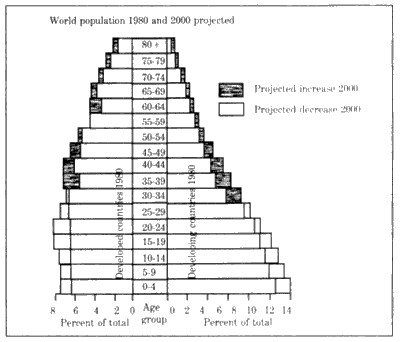
Figure 3-1: Cohort-survival
chart
4. Build power lines from the power plant to within one space of each
of the residential zones, and build roads from the industrial zone to within
one space of each of the residential zones.
5. Connect the final road sections to both zones.
6. Connect the power to the residential zone farthest from the industrial
zone first, followed by the one nearest the industrial zone.
Notice that the residential zone nearest the industrial zone will grow faster than the zone farther away.
This is not always as simple in reality as it is in SimCity. The SimCity model posits an isotropic transport plane. This means that distances are measured on an ideal plane where everything is equally accessible. The program simply checks for distance from the average geographical center of the population to determine land value (which, in turn, determines whether the zone is growing, stagnant, or declining through decay and migration).
In actuality, the accessibility of a given urban center from a residential location is affected by terrain and transportation factors (availability of transport, amount of traffic or passenger density, commute time, and commute cost). People do not create mental maps of their urban areas to scale. Instead, they place landmarks on their maps based on their perceptions of distance, which are largely determined by their memory of the difficulty in getting to each landmark. Because there are so many variables involved in this process, SimCity simplifies the problem by using the isotropic transport plane.
In the quick experiment suggested as a test for the rent/bid gradient, there were no commercial zones added to the mix of services for the economy. In terms of game play, however, SimCity requires a balance between the number of industrial, commercial, and residential zones in order to maximize the availability of jobs. Every month, in game time, the program evaluates each residential zone in terms of land value, availability of jobs, and a quality of life quotient that considers pollution, crime, parks, and accessibility. An efficient, high-scoring city will try to keep all of these factors in balance.
People Who Need People:
Commercial Considerations
The rent/bid gradient is even steeper for commercial developments than
it is for residential properties. In SimCity, as in real life, location
is a dominant factor in determining the viability of a commercial development.
The program evaluates commercial zones based on a radius of influence.
Each commercial zone is evaluated according to the accessibility of customers
(residential zones), a hidden variable representing an internal market
share (not in the Commodore version), and the overall balance between
commercial, industrial, and residential zones.
The necessity for balance reflects an authentic economic principle known as the export multiplier effect. A well-integrated manufacturing center not only produces income from the export of manufactured goods, but its economy is stimulated as new imports return to the manufacturing center. Some of these new imports could be raw materials or machines to enhance production in the exporting industry, but other imports will enlarge the rest of the manufacturing center's economy by becoming part of a local support industry's manufacturing chain (for example, machine parts for a local mechanic to use in repairing the exporting manufacturer's machines or in building new machines) or by entering the wholesale and retail economy. In the case of the former, the local economy will very likely be enlarged when the local supplier decides to export his machinery or expertise to another manufacturing center. Then his exports generate new imports, which add further to the local economy's growth momentum.
There is another multiplier effect, which takes place when a local economy begins to manufacture items to replace those items that the manufacturing center once only imported. This is called the import replacing multiplier effect. This principle states simply that when an urban center begins to produce those items that it once imported, it creates a larger economy by virtue of establishing greater demand. For example, a city that imports textiles begins to develop its own textile industry. This creates an influx of textile workers who must, in turn. purchase clothes made from some of the fabrics produced in the local economy. Hence, the internal demand for textiles has exceeded the amount that used to he imported. Other factors, such as reduced transportation costs and increased supply, reduce the basic prices entered into this growth figure, hut the point is valid nonetheless.
In SimCity, you only need to manage the export multiplier effect. Here are a few guidelines for your consideration. In actual city economics, a city that is primarily a manufacturing center may use nearly 70 percent of its industrial production for supplying external markets, and a city that is primarily a commercial center may use nearly 60 percent of its commercial production to support internal markets.
Because it is the support of the internal market that really makes a city take off economically, it should he your goal to reach commercial center status at the earliest possible moment. In SimCity, the external/internal market ratio starts out at 3:1 (the external market is three times greater than the internal market). As the city's size increases, the ratio is reduced to 2:1 and then 1:1 before it finally flip-flops to 1:2, and so forth. In cities in general, the multiplier generally gains momentum at around 200,000 total population. In SimCity, the multiplier usually kicks in earlier and really starts to accelerate when the total population is between 200,000 and 500,000.
A city that produces more for its internal market than it does for the external market is actually more self-sufficient and, consequently, less vulnerable to external market conditions. SimCity simplifies matters by arbitrarily deciding that all commercial production is for the internal market and all industrial production for the external market.
SimCity's documentation states that the ideal balance between zones is for the sum of commercial and industrial zones to equal the total number of residential zones. The preceding discussion indicates that you should have more industrial zones than commercial zones during the early history of your city and more commercial zones than industrial zones when you reach the metropolis stage.
Industrial Strength Planner:
Industrial Considerations
The SimCity program evaluates industrial zones with far less complex
calculations than those related to commercial and residential zones. When
the industrial zone is evaluated, the program simply wants to know whether
the zone is connected to the power grid or not and whether your "Sims"
can get to work or not. The zone is upgraded or downgraded on that basis
and the result of that function is looped hack into the calculation for
evaluating residential zones (which, in turn, causes a ripple effect through
the entire model). You should also remember that there is a point in the
game when you will need a seaport in order to support full industrial development.
Industrial zones have several positive effects in the SimCity model, but there is a negative effect that should be emphasized. Because industrial zones contribute to pollution, and pollution subsequently reduces land value, causing migration and reduced population, it is a good idea to segregate the manufacturing areas of your city from the residential areas.
Urban Jungle: Population
Density
High levels of population density tend to signal increases in the crime
rate, overcrowding, and slum conditions. Many urban planners insist that
this does not have to be the case. Indeed, Tokyo has a much higher population
density than New York City with only around ten percent of the crime. Nevertheless,
SimCity generalizes this factor and posits a direct relationship between
rising population density and increasing crime. It is possible, however,
to apply some of the lessons taught by urban planners to your city and
reduce the negative effects of high population density.
Many people confuse a concentration of population with overcrowding and poverty. As the visionary Le Corbusier observed, concentration does not have to equal congestion. His perspective was that high-density apartment buildings and office spaces would allow for surrounding open spaces, which could enhance the quality of life.
If one can guarantee that open space will be available for public use as compensation for high-rise buildings, Le Corbusier is probably correct. In modern America, however, territory that would ideally be alloted for open space tends to be usurped by other urban demands. In particular, housing that can support roughly 400 persons per acre requires a parking structure large enough to devour space that could otherwise be utilized for gardens, patios, and playgrounds. An office building that holds 1,200 persons per acre would require a three- or four-story parking garage where one would prefer a park. "The 'green' space to which we aspire and which offers much promise," observe Gallion and Eisner, in The Urban Pattern: City Planning and Design, "actually becomes a pavement for the vehicles of transportation." Fortunately, the SimCity player can be somewhat more successful in alternating green belts with high concentrations of population than most urban planners. The SimCity model does not require you to build parking structures. Therefore, you do not have to bulldoze any terrain other than that which is needed to develop the residential zone itself. This means that you can conserve an incredible amount of available forest and shoreline. Because forests and shorelines add to land value and a higher land value reduces crime, building residential areas next to open spaces limits some of the negatives created by high population density. Because planting parks also adds to land value, an aggressive park building campaign can reduce some of the negative factors associated with high-density population centers.
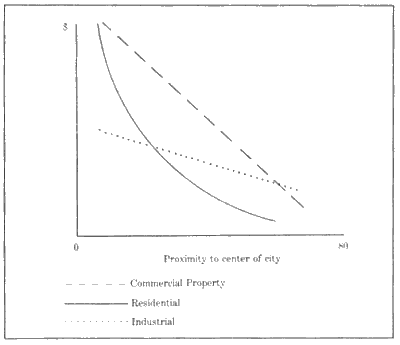
Figure 3-2: The
rent/bid gradient
Another way to slow the growth of the crime rate is to strategically place new police departments. Placing a police department in a high population density area does directly reduce the crime rate, but it does not directly increase the land value and cause a corresponding increase in the amount of taxes collected. By lowering the crime rate, it indirectly raises land values and enhances the taxes collected. Generally speaking, however, new police precincts add to the expense side of the city ledger.
Alert SimCity players have also noted that redevelopment does not work. When land value drops significantly in one of your city's zones, the terrain tiles that depict the buildings in that zone will begin to show decay. My initial impression was that the buildings simply needed demolishing so that new buildings could be constructed. This doesn't work.
When buildings start to decay in SimCity, this is not a function of the buildings themselves. It has nothing to do with the type of buildings in the zone. It is a result of the land value function. This discussion brings to mind the misguided warning posted on a BBS by a novice player: "Watch out for low-valued churches!" as though it were the church bringing the zone down. Instead, it was the land value in the zone bringing the church's value down (unintentionally representative of vandalism, perhaps?).
Therefore, you must solve inner city decay by working on the surrounding problems, rather than attempting a simple, but ineffective, redevelopment program. You must reduce pollution, crime, population density, traffic, and economic stagnation if you wish to revive the values of these zones. As in real life, government-subsidized housing will not accomplish enough if the root cause of an area's problem is, for example, unemployment.
Pop! Go the People!: Important
Calculations
The final topic of this chapter concerns how the calculations related
to population fit together with the changes in your city. First, note that
every zone on the map is periodically updated as the EvalPop (evaluate
population) function is called. Second, pay attention to the spiral effect
in which higher crime and higher population density lead to lower land
value. When these factors are updated, the lower land value can cause further
ripple effects in your city's economy.
© Copyright 1990 by Osborne/McGraw-Hill, 2600 Tenth St., Berkeley, CA 94710. SimCity is a registered trademark of Maxis Software.